Health Behavior Change: Model/Theory Table Assignment - I-Learn
VerifiedAdded on 2023/05/29
|7
|2083
|267
Homework Assignment
AI Summary
This assignment focuses on creating a comprehensive table of various health behavior change models and theories, utilizing resources from I-Learn and the textbook. The table includes a description of each model/theory, its constructs (with explanations), and the types of health issues it is best suited for. Models covered include Stimulus Response (SR) Theory, Theory of Reasoned Action (TRA)/Theory of Planned Behavior (TPB), Health Belief Model (HBM), Protection Motivation Theory (PMT), Elaboration Likelihood Model of Persuasion (ELM), Information-Motivation-Behavioral Skills Model (IMB), Transtheoretical Model (TTM), Precaution Adoption Process Model (PAPM), Social Cognitive Theory (SCT), Social Network Theory (SNT), Social Capital Theory, Communication Theory, Community Organizing, Community Building, Diffusion of Innovations, and Community Readiness Model (CRM). The assignment concludes with a justification for selecting the Health Belief Model for a specific public health issue.
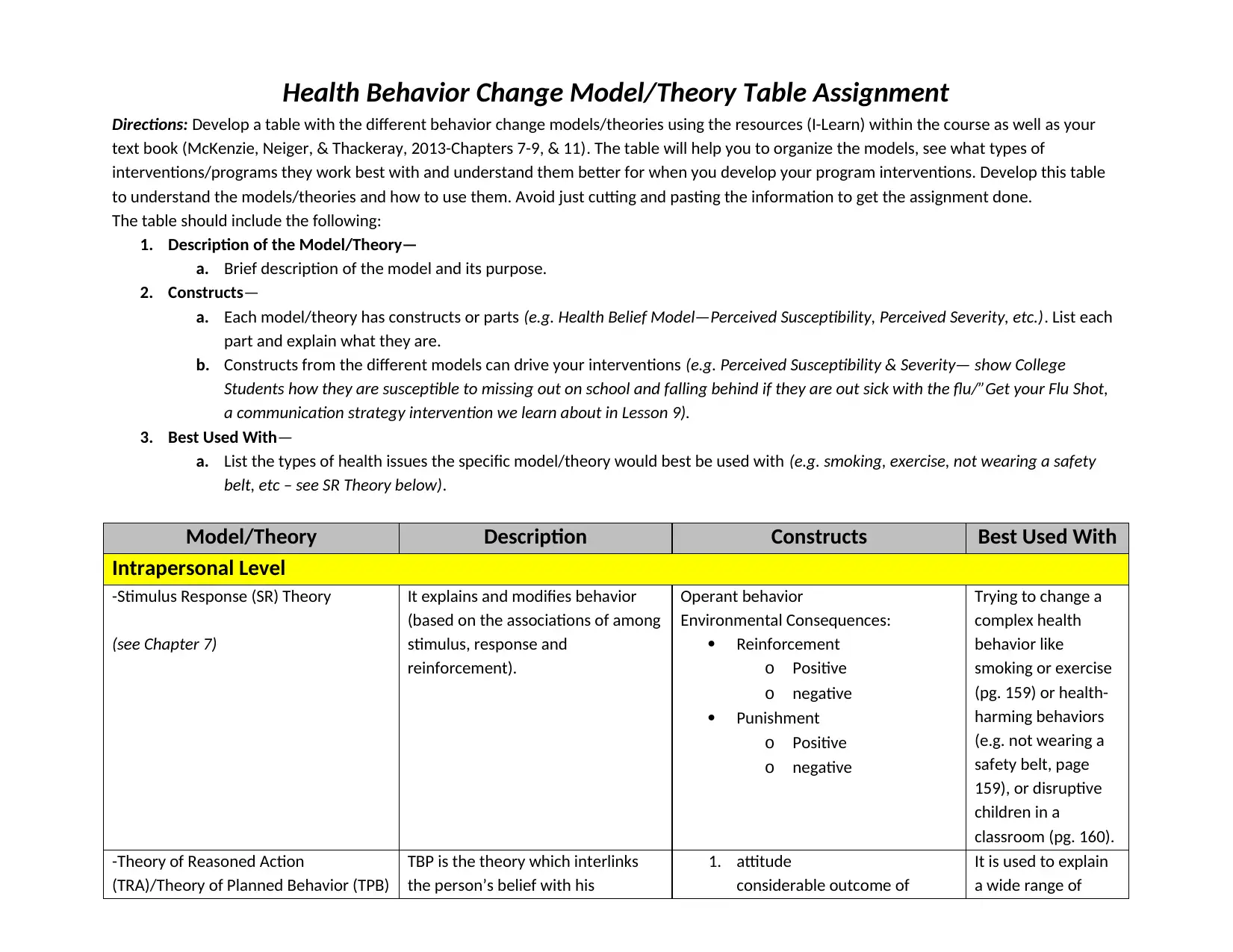
Health Behavior Change Model/Theory Table Assignment
Directions: Develop a table with the different behavior change models/theories using the resources (I-Learn) within the course as well as your
text book (McKenzie, Neiger, & Thackeray, 2013-Chapters 7-9, & 11). The table will help you to organize the models, see what types of
interventions/programs they work best with and understand them better for when you develop your program interventions. Develop this table
to understand the models/theories and how to use them. Avoid just cutting and pasting the information to get the assignment done.
The table should include the following:
1. Description of the Model/Theory—
a. Brief description of the model and its purpose.
2. Constructs—
a. Each model/theory has constructs or parts (e.g. Health Belief Model—Perceived Susceptibility, Perceived Severity, etc.). List each
part and explain what they are.
b. Constructs from the different models can drive your interventions (e.g. Perceived Susceptibility & Severity— show College
Students how they are susceptible to missing out on school and falling behind if they are out sick with the flu/”Get your Flu Shot,
a communication strategy intervention we learn about in Lesson 9).
3. Best Used With—
a. List the types of health issues the specific model/theory would best be used with (e.g. smoking, exercise, not wearing a safety
belt, etc – see SR Theory below).
Model/Theory Description Constructs Best Used With
Intrapersonal Level
-Stimulus Response (SR) Theory
(see Chapter 7)
It explains and modifies behavior
(based on the associations of among
stimulus, response and
reinforcement).
Operant behavior
Environmental Consequences:
Reinforcement
o Positive
o negative
Punishment
o Positive
o negative
Trying to change a
complex health
behavior like
smoking or exercise
(pg. 159) or health-
harming behaviors
(e.g. not wearing a
safety belt, page
159), or disruptive
children in a
classroom (pg. 160).
-Theory of Reasoned Action
(TRA)/Theory of Planned Behavior (TPB)
TBP is the theory which interlinks
the person’s belief with his
1. attitude
considerable outcome of
It is used to explain
a wide range of
Directions: Develop a table with the different behavior change models/theories using the resources (I-Learn) within the course as well as your
text book (McKenzie, Neiger, & Thackeray, 2013-Chapters 7-9, & 11). The table will help you to organize the models, see what types of
interventions/programs they work best with and understand them better for when you develop your program interventions. Develop this table
to understand the models/theories and how to use them. Avoid just cutting and pasting the information to get the assignment done.
The table should include the following:
1. Description of the Model/Theory—
a. Brief description of the model and its purpose.
2. Constructs—
a. Each model/theory has constructs or parts (e.g. Health Belief Model—Perceived Susceptibility, Perceived Severity, etc.). List each
part and explain what they are.
b. Constructs from the different models can drive your interventions (e.g. Perceived Susceptibility & Severity— show College
Students how they are susceptible to missing out on school and falling behind if they are out sick with the flu/”Get your Flu Shot,
a communication strategy intervention we learn about in Lesson 9).
3. Best Used With—
a. List the types of health issues the specific model/theory would best be used with (e.g. smoking, exercise, not wearing a safety
belt, etc – see SR Theory below).
Model/Theory Description Constructs Best Used With
Intrapersonal Level
-Stimulus Response (SR) Theory
(see Chapter 7)
It explains and modifies behavior
(based on the associations of among
stimulus, response and
reinforcement).
Operant behavior
Environmental Consequences:
Reinforcement
o Positive
o negative
Punishment
o Positive
o negative
Trying to change a
complex health
behavior like
smoking or exercise
(pg. 159) or health-
harming behaviors
(e.g. not wearing a
safety belt, page
159), or disruptive
children in a
classroom (pg. 160).
-Theory of Reasoned Action
(TRA)/Theory of Planned Behavior (TPB)
TBP is the theory which interlinks
the person’s belief with his
1. attitude
considerable outcome of
It is used to explain
a wide range of
Paraphrase This Document
Need a fresh take? Get an instant paraphrase of this document with our AI Paraphraser

(see Chapter 7)
behavior. as per this theory attitude
towards someone’s behavior,
different subjective norms and
perceived behavioral norms are
effective in shaping the mind of
people their behavior and intentions
performing the behavior
2. behavioral intention
these are the motivational
factor that let the person
perform the cation
3. subjective norms
it provides an idea to the
people that he or she should
perform the behavior
4. social norm
these are standards for a larger
cultural context
5. perceived power
it contributes to a persons
perceived behavior
6. perceived behavioral control
it is the persons perception
about the ease or difficulty of
the situation (Zimmerman,
2013)
health behaviors
and intentions such
as smoking, health
service utilization,
substance abuse,
drinking and others
-Health Belief Model (HBM)
(see Chapter 7, PowerPoint & Theories
at a Glance)
This model helps to explain as well
as tries to predict the human
behavior by their attitudes and
beliefs.
1. perceived susceptibility
2. perceived severity
3. perceived benefits
4. perceived barriers
This is used to
derive different long
and short term
health behaviors
and different
changing habitual
behaviors such as
sedentary lifestyle,
overeating, smoking
and others (Golden
& Earp, 2012).
-Protection Motivation Theory (PMT)
(see Chapter 7 & chapter 7 PowerPoint)
This theory was developed to
provide a clear and concise idea
about fear appeals further which
was upgraded to persuasive
Threat appraisal
Assess maladaptive behaviors:
1. perceived severity
2. perceived probability
This theory was
applied to
determine the use
of alcohol,
behavior. as per this theory attitude
towards someone’s behavior,
different subjective norms and
perceived behavioral norms are
effective in shaping the mind of
people their behavior and intentions
performing the behavior
2. behavioral intention
these are the motivational
factor that let the person
perform the cation
3. subjective norms
it provides an idea to the
people that he or she should
perform the behavior
4. social norm
these are standards for a larger
cultural context
5. perceived power
it contributes to a persons
perceived behavior
6. perceived behavioral control
it is the persons perception
about the ease or difficulty of
the situation (Zimmerman,
2013)
health behaviors
and intentions such
as smoking, health
service utilization,
substance abuse,
drinking and others
-Health Belief Model (HBM)
(see Chapter 7, PowerPoint & Theories
at a Glance)
This model helps to explain as well
as tries to predict the human
behavior by their attitudes and
beliefs.
1. perceived susceptibility
2. perceived severity
3. perceived benefits
4. perceived barriers
This is used to
derive different long
and short term
health behaviors
and different
changing habitual
behaviors such as
sedentary lifestyle,
overeating, smoking
and others (Golden
& Earp, 2012).
-Protection Motivation Theory (PMT)
(see Chapter 7 & chapter 7 PowerPoint)
This theory was developed to
provide a clear and concise idea
about fear appeals further which
was upgraded to persuasive
Threat appraisal
Assess maladaptive behaviors:
1. perceived severity
2. perceived probability
This theory was
applied to
determine the use
of alcohol,
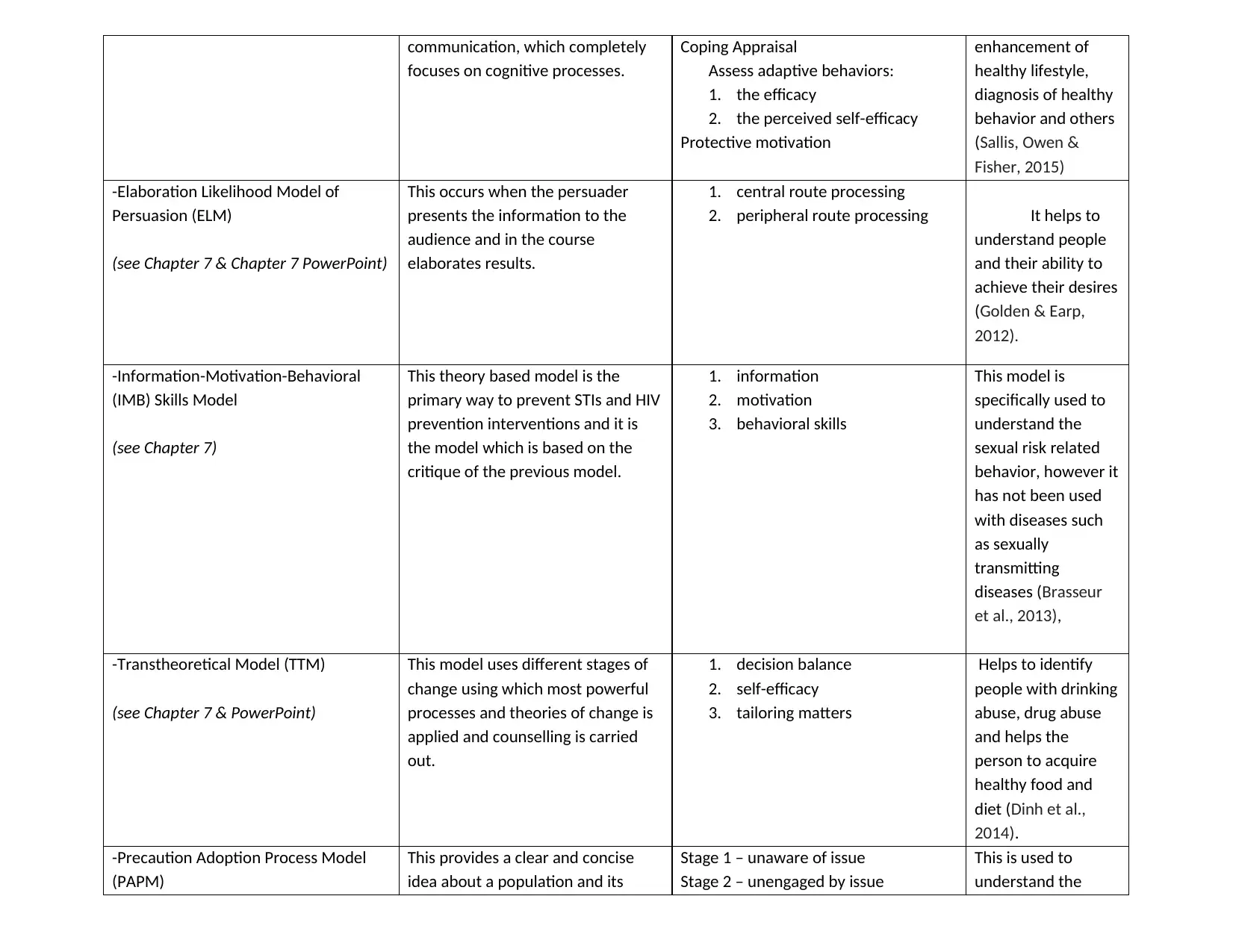
communication, which completely
focuses on cognitive processes.
Coping Appraisal
Assess adaptive behaviors:
1. the efficacy
2. the perceived self-efficacy
Protective motivation
enhancement of
healthy lifestyle,
diagnosis of healthy
behavior and others
(Sallis, Owen &
Fisher, 2015)
-Elaboration Likelihood Model of
Persuasion (ELM)
(see Chapter 7 & Chapter 7 PowerPoint)
This occurs when the persuader
presents the information to the
audience and in the course
elaborates results.
1. central route processing
2. peripheral route processing It helps to
understand people
and their ability to
achieve their desires
(Golden & Earp,
2012).
-Information-Motivation-Behavioral
(IMB) Skills Model
(see Chapter 7)
This theory based model is the
primary way to prevent STIs and HIV
prevention interventions and it is
the model which is based on the
critique of the previous model.
1. information
2. motivation
3. behavioral skills
This model is
specifically used to
understand the
sexual risk related
behavior, however it
has not been used
with diseases such
as sexually
transmitting
diseases (Brasseur
et al., 2013),
-Transtheoretical Model (TTM)
(see Chapter 7 & PowerPoint)
This model uses different stages of
change using which most powerful
processes and theories of change is
applied and counselling is carried
out.
1. decision balance
2. self-efficacy
3. tailoring matters
Helps to identify
people with drinking
abuse, drug abuse
and helps the
person to acquire
healthy food and
diet (Dinh et al.,
2014).
-Precaution Adoption Process Model
(PAPM)
This provides a clear and concise
idea about a population and its
Stage 1 – unaware of issue
Stage 2 – unengaged by issue
This is used to
understand the
focuses on cognitive processes.
Coping Appraisal
Assess adaptive behaviors:
1. the efficacy
2. the perceived self-efficacy
Protective motivation
enhancement of
healthy lifestyle,
diagnosis of healthy
behavior and others
(Sallis, Owen &
Fisher, 2015)
-Elaboration Likelihood Model of
Persuasion (ELM)
(see Chapter 7 & Chapter 7 PowerPoint)
This occurs when the persuader
presents the information to the
audience and in the course
elaborates results.
1. central route processing
2. peripheral route processing It helps to
understand people
and their ability to
achieve their desires
(Golden & Earp,
2012).
-Information-Motivation-Behavioral
(IMB) Skills Model
(see Chapter 7)
This theory based model is the
primary way to prevent STIs and HIV
prevention interventions and it is
the model which is based on the
critique of the previous model.
1. information
2. motivation
3. behavioral skills
This model is
specifically used to
understand the
sexual risk related
behavior, however it
has not been used
with diseases such
as sexually
transmitting
diseases (Brasseur
et al., 2013),
-Transtheoretical Model (TTM)
(see Chapter 7 & PowerPoint)
This model uses different stages of
change using which most powerful
processes and theories of change is
applied and counselling is carried
out.
1. decision balance
2. self-efficacy
3. tailoring matters
Helps to identify
people with drinking
abuse, drug abuse
and helps the
person to acquire
healthy food and
diet (Dinh et al.,
2014).
-Precaution Adoption Process Model
(PAPM)
This provides a clear and concise
idea about a population and its
Stage 1 – unaware of issue
Stage 2 – unengaged by issue
This is used to
understand the
⊘ This is a preview!⊘
Do you want full access?
Subscribe today to unlock all pages.

Trusted by 1+ million students worldwide

(see Chapter 7)
thinking about the process and
helps to identify the transition of
people from non-conscious to
conscious about their health.
Stage 3 – undecided about acting
Stage 4 – decided not to act
Stage 5 – decided to act
Stage 6 – acting
Stage 7 – maintenance
concept and
mindset of a
complete
community about a
helathcare condition
so that their
understanding
about the process
could be easily
understood (Weiner
et al., 2012).
Interpersonal Level
-Social Cognitive Theory (SCT)
(see Chapter 7)
The unique nature of this theory is
determined by its emphasis on the
internal as well as external social
reinforcements.
1. Reciprocal Determinism
2. Behavioral Capability
3. Self-efficacy
4. Expectations
5. Reinforcements
6. Observational Learning
This focuses on the
past experiences of
the person to
determine its
present nature and
the reason of
engagement to a
specific behavior
(Sallis, Owen &
Fisher, 2015)
-Social Network Theory (SNT)
(see Chapter 7)
This describes the social structure,
support and health of the society
and it explains the social
relationship with its theories
density
homogeneity
geographic dispersion
directionality
This is used to
identify and
compare the social
comparison, social
influence, and
companionship
(Dinh et al., 2014).
-Social Capital Theory
(see Chapter 7)
It focuses on the connections people
have within their friends and family
Environment
networks
relationships
trust and reciprocity
Social Capitol
(see Figure 7.8 on page 182)
This helps in
identification of
shared identification
of people who are
connected with
others through
social connection
thinking about the process and
helps to identify the transition of
people from non-conscious to
conscious about their health.
Stage 3 – undecided about acting
Stage 4 – decided not to act
Stage 5 – decided to act
Stage 6 – acting
Stage 7 – maintenance
concept and
mindset of a
complete
community about a
helathcare condition
so that their
understanding
about the process
could be easily
understood (Weiner
et al., 2012).
Interpersonal Level
-Social Cognitive Theory (SCT)
(see Chapter 7)
The unique nature of this theory is
determined by its emphasis on the
internal as well as external social
reinforcements.
1. Reciprocal Determinism
2. Behavioral Capability
3. Self-efficacy
4. Expectations
5. Reinforcements
6. Observational Learning
This focuses on the
past experiences of
the person to
determine its
present nature and
the reason of
engagement to a
specific behavior
(Sallis, Owen &
Fisher, 2015)
-Social Network Theory (SNT)
(see Chapter 7)
This describes the social structure,
support and health of the society
and it explains the social
relationship with its theories
density
homogeneity
geographic dispersion
directionality
This is used to
identify and
compare the social
comparison, social
influence, and
companionship
(Dinh et al., 2014).
-Social Capital Theory
(see Chapter 7)
It focuses on the connections people
have within their friends and family
Environment
networks
relationships
trust and reciprocity
Social Capitol
(see Figure 7.8 on page 182)
This helps in
identification of
shared identification
of people who are
connected with
others through
social connection
Paraphrase This Document
Need a fresh take? Get an instant paraphrase of this document with our AI Paraphraser
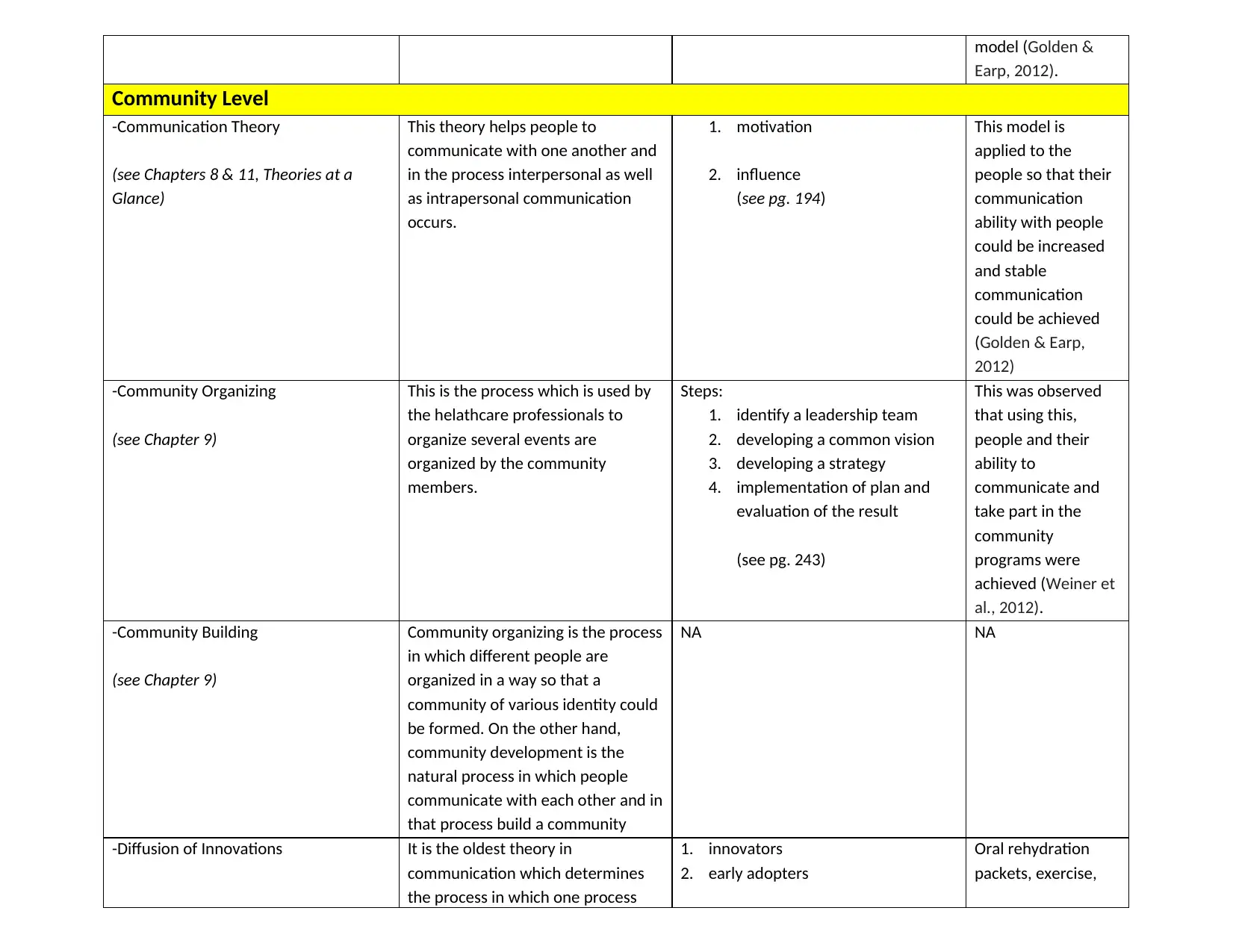
model (Golden &
Earp, 2012).
Community Level
-Communication Theory
(see Chapters 8 & 11, Theories at a
Glance)
This theory helps people to
communicate with one another and
in the process interpersonal as well
as intrapersonal communication
occurs.
1. motivation
2. influence
(see pg. 194)
This model is
applied to the
people so that their
communication
ability with people
could be increased
and stable
communication
could be achieved
(Golden & Earp,
2012)
-Community Organizing
(see Chapter 9)
This is the process which is used by
the helathcare professionals to
organize several events are
organized by the community
members.
Steps:
1. identify a leadership team
2. developing a common vision
3. developing a strategy
4. implementation of plan and
evaluation of the result
(see pg. 243)
This was observed
that using this,
people and their
ability to
communicate and
take part in the
community
programs were
achieved (Weiner et
al., 2012).
-Community Building
(see Chapter 9)
Community organizing is the process
in which different people are
organized in a way so that a
community of various identity could
be formed. On the other hand,
community development is the
natural process in which people
communicate with each other and in
that process build a community
NA NA
-Diffusion of Innovations It is the oldest theory in
communication which determines
the process in which one process
1. innovators
2. early adopters
Oral rehydration
packets, exercise,
Earp, 2012).
Community Level
-Communication Theory
(see Chapters 8 & 11, Theories at a
Glance)
This theory helps people to
communicate with one another and
in the process interpersonal as well
as intrapersonal communication
occurs.
1. motivation
2. influence
(see pg. 194)
This model is
applied to the
people so that their
communication
ability with people
could be increased
and stable
communication
could be achieved
(Golden & Earp,
2012)
-Community Organizing
(see Chapter 9)
This is the process which is used by
the helathcare professionals to
organize several events are
organized by the community
members.
Steps:
1. identify a leadership team
2. developing a common vision
3. developing a strategy
4. implementation of plan and
evaluation of the result
(see pg. 243)
This was observed
that using this,
people and their
ability to
communicate and
take part in the
community
programs were
achieved (Weiner et
al., 2012).
-Community Building
(see Chapter 9)
Community organizing is the process
in which different people are
organized in a way so that a
community of various identity could
be formed. On the other hand,
community development is the
natural process in which people
communicate with each other and in
that process build a community
NA NA
-Diffusion of Innovations It is the oldest theory in
communication which determines
the process in which one process
1. innovators
2. early adopters
Oral rehydration
packets, exercise,
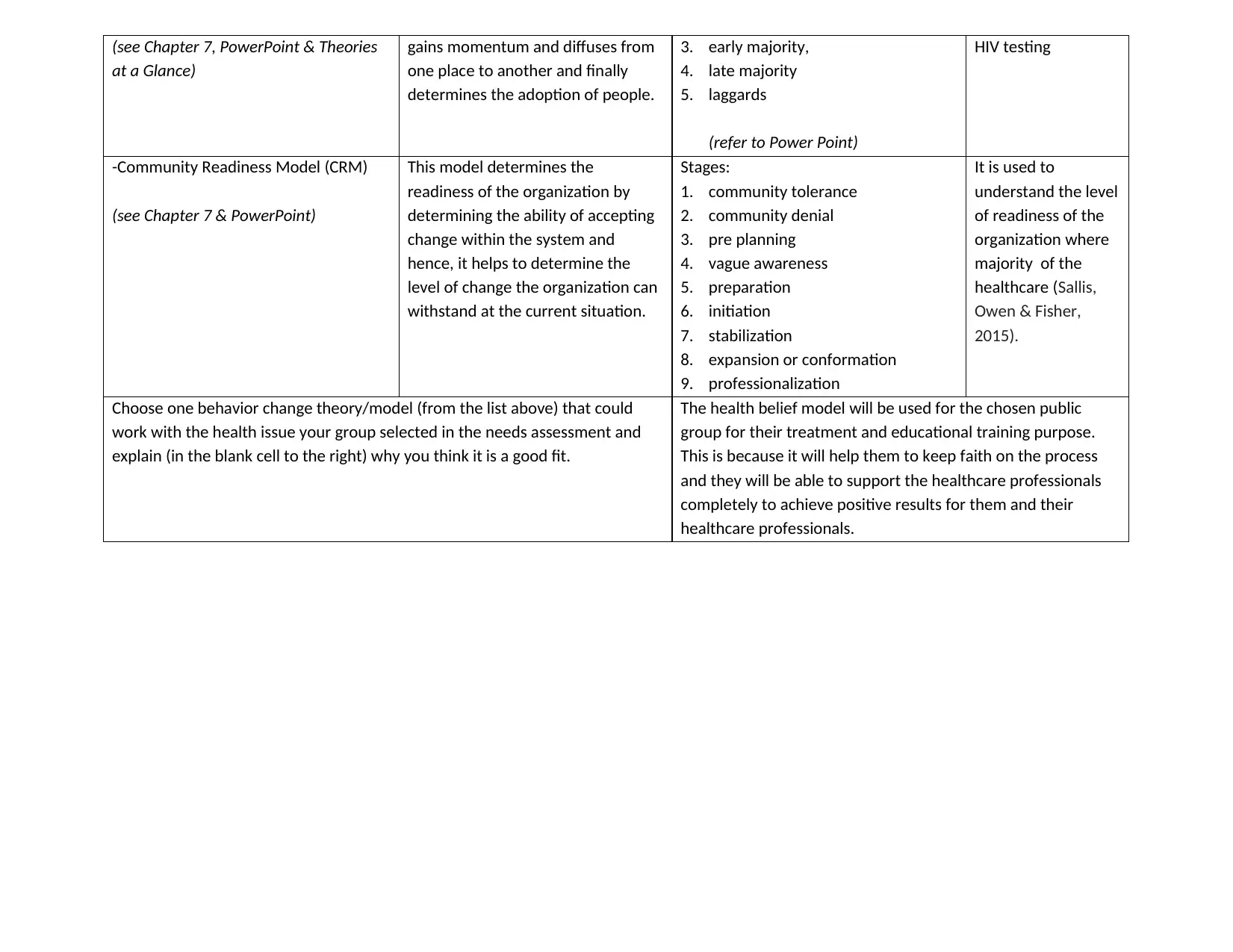
(see Chapter 7, PowerPoint & Theories
at a Glance)
gains momentum and diffuses from
one place to another and finally
determines the adoption of people.
3. early majority,
4. late majority
5. laggards
(refer to Power Point)
HIV testing
-Community Readiness Model (CRM)
(see Chapter 7 & PowerPoint)
This model determines the
readiness of the organization by
determining the ability of accepting
change within the system and
hence, it helps to determine the
level of change the organization can
withstand at the current situation.
Stages:
1. community tolerance
2. community denial
3. pre planning
4. vague awareness
5. preparation
6. initiation
7. stabilization
8. expansion or conformation
9. professionalization
It is used to
understand the level
of readiness of the
organization where
majority of the
healthcare (Sallis,
Owen & Fisher,
2015).
Choose one behavior change theory/model (from the list above) that could
work with the health issue your group selected in the needs assessment and
explain (in the blank cell to the right) why you think it is a good fit.
The health belief model will be used for the chosen public
group for their treatment and educational training purpose.
This is because it will help them to keep faith on the process
and they will be able to support the healthcare professionals
completely to achieve positive results for them and their
healthcare professionals.
at a Glance)
gains momentum and diffuses from
one place to another and finally
determines the adoption of people.
3. early majority,
4. late majority
5. laggards
(refer to Power Point)
HIV testing
-Community Readiness Model (CRM)
(see Chapter 7 & PowerPoint)
This model determines the
readiness of the organization by
determining the ability of accepting
change within the system and
hence, it helps to determine the
level of change the organization can
withstand at the current situation.
Stages:
1. community tolerance
2. community denial
3. pre planning
4. vague awareness
5. preparation
6. initiation
7. stabilization
8. expansion or conformation
9. professionalization
It is used to
understand the level
of readiness of the
organization where
majority of the
healthcare (Sallis,
Owen & Fisher,
2015).
Choose one behavior change theory/model (from the list above) that could
work with the health issue your group selected in the needs assessment and
explain (in the blank cell to the right) why you think it is a good fit.
The health belief model will be used for the chosen public
group for their treatment and educational training purpose.
This is because it will help them to keep faith on the process
and they will be able to support the healthcare professionals
completely to achieve positive results for them and their
healthcare professionals.
⊘ This is a preview!⊘
Do you want full access?
Subscribe today to unlock all pages.

Trusted by 1+ million students worldwide
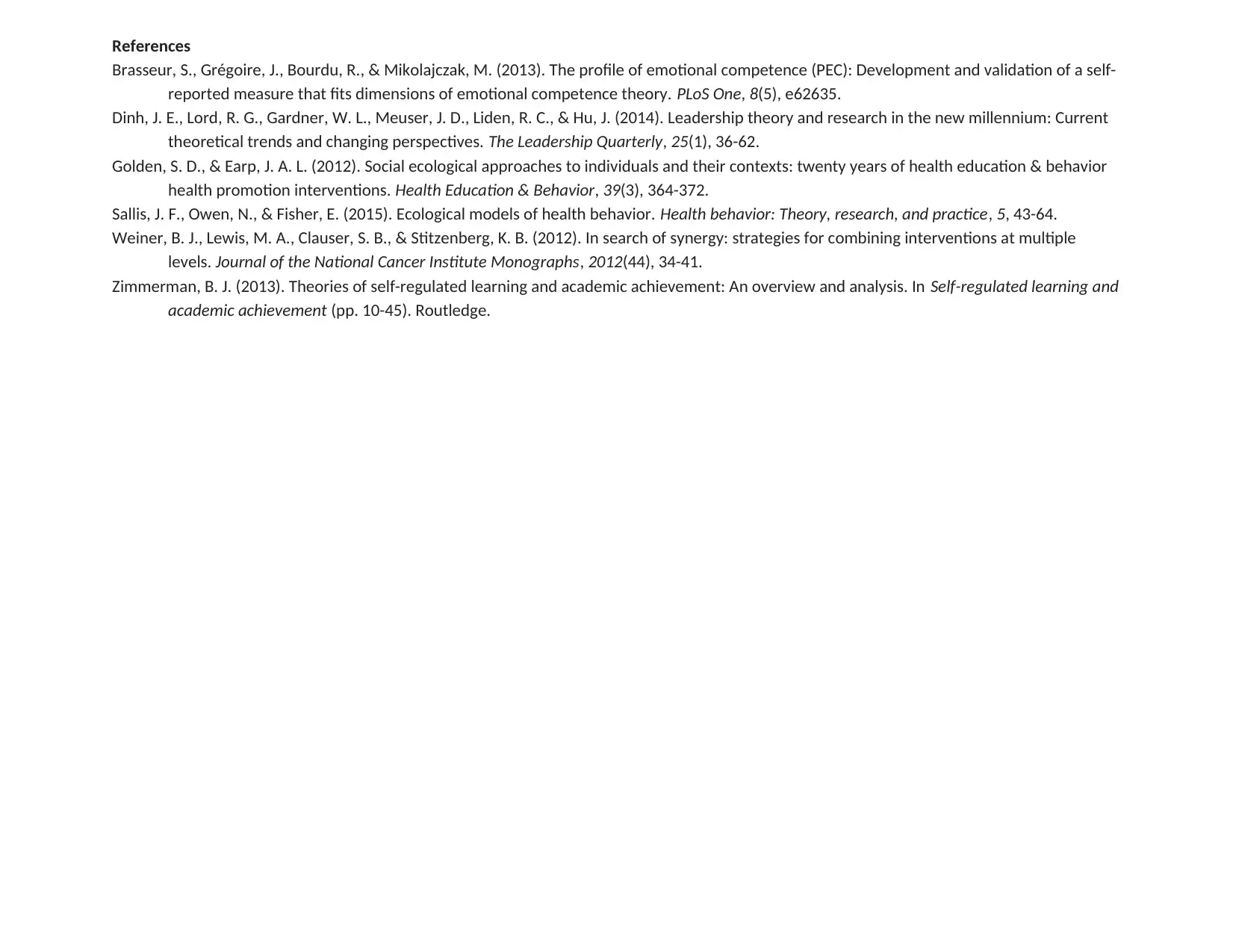
References
Brasseur, S., Grégoire, J., Bourdu, R., & Mikolajczak, M. (2013). The profile of emotional competence (PEC): Development and validation of a self-
reported measure that fits dimensions of emotional competence theory. PLoS One, 8(5), e62635.
Dinh, J. E., Lord, R. G., Gardner, W. L., Meuser, J. D., Liden, R. C., & Hu, J. (2014). Leadership theory and research in the new millennium: Current
theoretical trends and changing perspectives. The Leadership Quarterly, 25(1), 36-62.
Golden, S. D., & Earp, J. A. L. (2012). Social ecological approaches to individuals and their contexts: twenty years of health education & behavior
health promotion interventions. Health Education & Behavior, 39(3), 364-372.
Sallis, J. F., Owen, N., & Fisher, E. (2015). Ecological models of health behavior. Health behavior: Theory, research, and practice, 5, 43-64.
Weiner, B. J., Lewis, M. A., Clauser, S. B., & Stitzenberg, K. B. (2012). In search of synergy: strategies for combining interventions at multiple
levels. Journal of the National Cancer Institute Monographs, 2012(44), 34-41.
Zimmerman, B. J. (2013). Theories of self-regulated learning and academic achievement: An overview and analysis. In Self-regulated learning and
academic achievement (pp. 10-45). Routledge.
Brasseur, S., Grégoire, J., Bourdu, R., & Mikolajczak, M. (2013). The profile of emotional competence (PEC): Development and validation of a self-
reported measure that fits dimensions of emotional competence theory. PLoS One, 8(5), e62635.
Dinh, J. E., Lord, R. G., Gardner, W. L., Meuser, J. D., Liden, R. C., & Hu, J. (2014). Leadership theory and research in the new millennium: Current
theoretical trends and changing perspectives. The Leadership Quarterly, 25(1), 36-62.
Golden, S. D., & Earp, J. A. L. (2012). Social ecological approaches to individuals and their contexts: twenty years of health education & behavior
health promotion interventions. Health Education & Behavior, 39(3), 364-372.
Sallis, J. F., Owen, N., & Fisher, E. (2015). Ecological models of health behavior. Health behavior: Theory, research, and practice, 5, 43-64.
Weiner, B. J., Lewis, M. A., Clauser, S. B., & Stitzenberg, K. B. (2012). In search of synergy: strategies for combining interventions at multiple
levels. Journal of the National Cancer Institute Monographs, 2012(44), 34-41.
Zimmerman, B. J. (2013). Theories of self-regulated learning and academic achievement: An overview and analysis. In Self-regulated learning and
academic achievement (pp. 10-45). Routledge.
1 out of 7
Your All-in-One AI-Powered Toolkit for Academic Success.
+13062052269
info@desklib.com
Available 24*7 on WhatsApp / Email
![[object Object]](/_next/static/media/star-bottom.7253800d.svg)
Unlock your academic potential
Copyright © 2020–2025 A2Z Services. All Rights Reserved. Developed and managed by ZUCOL.